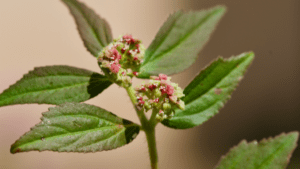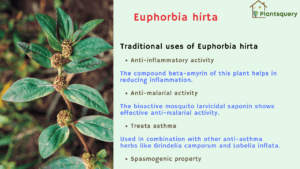Introduction
Euphorbia hirta is commonly known as Asthama weed, other names of this plant are common Spurge and Cats hair. It is a small herb belonging to the family Euphorbiaceae and distributed throughout India and other tropical countries. the plant parts are widely used in traditional systems of medicine for the treatment of respiratory diseases, gastrointestinal disorders, wound healing, pulmonary diseases, tumors, lactation, and urinogenital disorders (1). Euphorbia hirta benefits and side effects are as follows.
Botanical description

1. Height
The plant grows up to 40 cm tall
2. Leaves
The leaves are opposite, elliptic-oblong to oblong-lancelike, 1-2.5 cm long, blotched with purple in middle, and toothed at the edges.
3. Flowers
Flowers of Euphorbia are purple to green in color. dense, axillary, short-stalked cluster. Capsules are broadly ovoid, hairy, and three-angled about 1.5 cm.
Euphorbia hirta care and propagation
The plant is not very tolerant of frost. It can probably be grown successfully in cold countries as a spring plant. The ripe seed is released exponentially from the seed capsules. These pants are not eaten by any other animals because of their unique smell.
The germination of the seeds of Euphorbia hirta takes place within 2-3 weeks at 20 degrees. The seeds are first germinated in groups and then the plants are taken out and potted individually for proper growth and maturity.
Main components present in the Euphorbia hirta
Euphorbia hirta contains flavonoids, terpenoids, phenols, and essential oil.
Traditional uses of Euphorbia hirta
The plant is traditionally used to cure gastrointestinal disorders and bronchitis asthma. Important note the plant should not be used without expert guidance as large doses may cause gastrointestinal irritation and nausea with vomiting.
1. Anti-inflammatory activity
The plant Euphorbia hirta shows anti-inflammatory activity because of the compound beta-amyrin present in the extract of the plant (2).
2. anti-malarial activity
The bioactive mosquito larvicidal saponin is extracted from the plant which shows effective anti-malarial activity (3).
3. Treats asthma
The herb relaxes the bronchioles but apparently depresses the heart and general respiration. Used in combination with other anti-asthma herbs like Grindelia camporum and Lobelia inflata.
4. Spasmogenic property
The water extract of Euphorbia hirta is having a spasmogenic effect that induces spasms (4).
Other medicinal uses
The whole plant is used in the treatment of athlete’s foot, dysentery, and skin conditions. Also used in the treatment of syphilis. The sap of his plans is directly applied to warts at least 2-3 times a day for several weeks to cure the disease.
The main use of this plant is to cure lungs related issues like respiratory problems, asthma, bronchitis, and other lung complaints.
the sap of this plant is also used on cuts and wounds to prevent further infections. and attacks of other pathogens. the leaf decoction is used for treating ulcers and also the plant is eaten as vegetables.

